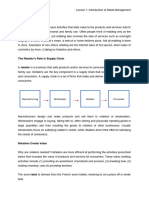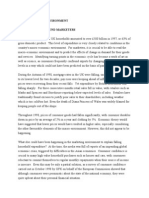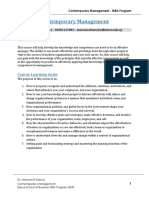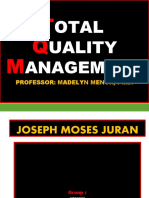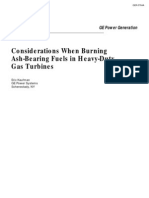Concept Paper Plastic Initiative
Concept Paper Plastic Initiative
Uploaded by
Raymundo Ungria Jr.Copyright:
Available Formats
Concept Paper Plastic Initiative
Concept Paper Plastic Initiative
Uploaded by
Raymundo Ungria Jr.Copyright
Available Formats
Share this document
Did you find this document useful?
Is this content inappropriate?
Copyright:
Available Formats
Concept Paper Plastic Initiative
Concept Paper Plastic Initiative
Uploaded by
Raymundo Ungria Jr.Copyright:
Available Formats
PLASTIC INITIATIVE
Introduction
According to a United Nations Environment Program report, the Philippines is the fourth largest
generator of solid waste among ASEAN member countries, producing 14.66 million tons of trash
per year. While an astounding 2.7 million tons of plastic waste are produced in the Philippines
each year, 20 percent of which is estimated to end up in the ocean (McKinsey, 2015). Moreover,
the indicated rising numbers, along with the community’s behavior, improper waste disposal,
and uncollected garbage, contribute a lot to the waste management system, especially at this time
of health crisis. Plastic consumption has significantly increased due to the COVID-19 pandemic.
With this being said, some of the factors subsidizing the problem are the heavy reliance on
disposable masks, face shields, personal protective equipment (PPE), syringes, and gloves. In
addition, the series of lockdowns and restrictions has caused the community to be dependent on
food deliveries, in which most of the transactions further add up to the single-used plastic
problem (utensils, bags, cups). Therefore, the harmful effects of plastic pollution are gradually
swelling because of the abundance of medical and e-commerce plastic waste in many areas.
Our group believes that the more voices we hear, whether they be from the community or the
environment, the more solutions we can create. We live up to the conviction that by minimizing
the risks coming from the environment itself, the community will be able to sustain its needs
without worrying much about the possible complications they may acquire from these hazards.
Purpose
The Plastic Initiative aims to provide a fresh and innovative solution to a long-standing problem
of Plastic Pollution in the community, and to further premeditate the occurrences of threats to
the people’s well-being in the next generations. Our group perceives the inter-relationship of the
community to the economy and the environment, hence, proposing a revolution where plastic
wastes are manufactured into supplies that can be used by the people. In light of this, our group
shall present a few methods that hereby recognize the existing ones that the community is also
allowed to adopt and show how they will greatly benefit the target and its broader affiliations.
Project Description
In an industry where plastic production is rampant, we suggest a solution that will make these
products purposeful. By this means, recycling will be more engaging and advantageous,
transforming plastic waste into building materials, furniture, and even home essentials. This kind
of method has already been introduced in a segment called “Juan for All, All for Juan” on national
television, where plastic bottles are converted into plastic chairs that are donated to schools, as
well as the recycling company based in Davao City, Philippines, named, “Envirotech Waste
Recycling Incorporated” that collects plastic trash and turns it into construction materials, which
gave birth to their latest project, “EnviroHome”. These are two of our inspirations in proposing
this venture.
On the needs of the community
Our project is not called “Plastic Initiative” for nothing. The title itself involves its target – the
community, which consists of the youth and the elderly. As previously stated, their involvement
in the project is not only for sustaining their needs but also the tangible and intangible benefits
they can obtain. Through selling their household plastic waste to junk shops, they are able to save
up a few extras for their investments and financial stability. Engaging in this initiative is also a
huge factor to develop their behavioral practices that affect their day-to-day lives. Another
element of the project is its ability to raise awareness of the negative effects of the dramatic
increase in plastic pollution and prevent the public’s health from contamination and biohazards.
Therefore, the reduction of plastics going to landfills and motivating family recycling programs
must be promoted so that the Local Government Units will provide only smaller trash bins for
every household and every member can practice discipline as part of their character building. In
the confidence of enlightenment, the community is constantly reminded of the importance of
proper waste disposal, along with the engaging productivity it upholds that heightens as their
physiological needs and interests are principally addressed.
Prior to the stated hypothesis, improper waste disposal can cause poor sanitary conditions, as
well as posing a lot of hazards to the human health and the natural resources of both social and
economic importance.
In line with the inter-connections, this project benefits the community in the same way it can
benefit the environment and the economy.
On sustaining the environment
The environment is the community itself and by preserving the environment means protecting
the community from the dangers it may bring. An example of these are the effects of natural
disasters, which are amplified by human activities such as disposing plastic trash that blocks
drainage canals that can also extend to other water systems. Many communities are also
struggling with a lack of access to potable water due to these coastal hazards. A study in
Dumaguete, Philippines found microplastics inside a frequently consumed fish that is being sold
in the public markets. This already specified how poor the local water systems and solid waste
management are, that even the marine resources are being put at risk. And if not immediately
resolved, this can similarly affect the communities in terms of health and natural perils.
With that, by the methods of this project, gathering all plastic wastes in the environment, it can
help diminish its risks to the community. Also, instead of cutting trees to make small furniture,
why not invest with something that is also produced? This promotes recycling already used
plastic as its main material to create new sustainable crafts, like arm-chairs and floormats. In that
way, it can also use its potential to mitigate the effects of typhoons and landslides, as well as to
combat local greenhouse gas emissions. Here, we are minimizing commercial loggings while
maximizing the transformation of plastic waste into various resourceful products.
The more the community gets involved in the ecological aspect, the less various diseases
proliferate in the environment, which is a big advantage in protecting the health of the
population.
On the escalating economy
Since this project is about manufacturing, it can afford to have jobs and business start-ups.
Through the use of social networking sites, the finished-products are going to be introduced to
the netizens, wherein, the message will swiftly reach out to potential investors or big
environmental organizations. Also, junk shop owners must still be open for individuals who wish
to sell their plastic waste in exchange of extra money. By this means, the economic cycle still goes
on due to commercial consumption and sales taxes. It can also help in a way that each local
government unit invests in acquiring this type of venture for its respective communities, and
establishing a workplace that offers livelihood. However, in the starting year of the innovation,
the participation of LGUs and junk shop owners in providing collected plastic wastes from the
communities is an initial alternative. And from there, it will go to the manufacturing company
where the production takes place. It will still accomplish its key objectives of eliminating plastic
waste.
Furthermore, our group envisions this project being widely adopted and attracting large
companies, which will eventually pave its way to the global market, allowing exportations of
products and recycling plant services to foreign countries in Asia-Pacific.
Objectives
Zero waste is impossible but innovation from wastes is attainable. An enduring problem requires
consistently driven solution. The Plastic Initiative is a long-term project and one of its primary
goals is to increase community initiatives for collecting plastic garbage in their respective areas
in order to reduce at least 60 to 90 tons of plastic waste every month. By then, the pollution
brought by plastic will be properly controlled and diminished until year 2050, when global
warming and climate change are said to be at their peak.
Methodology/Project Design
On the initiative of the community
The plastics are collected by the people in the community, may it be from their surroundings or
their household wastes, to be gathered by garbage collectors.
On the participation of LGU and junk shop owners
The plastics are gathered and segregated from other solid wastes so they will not be brought into
the landfills, whether they be from households or commercial buildings like public market and
small businesses, and are delivered to the recycling plants. Another alternative is acquiring
machines from incorporated suppliers to be used in their respective localities. From there on,
livelihoods will also be offered.
On the pioneering of project organizers
There will be a moderate vehicle provided that goes around the locality to collect the plastic
waste that will eventually be distributed to the recycling plants for production.
Project Needs
On the participation of the community
This requires accountability, discipline, and engagement from the community. Social media is
also one feature that can help in promoting good recycling behavior and awareness.
On the initiative of LGU and junk shop owners
This requires two to three personnel riding garbage-collecting vehicles every day. If acquiring an
investment machine, it will cost around ₱280,000 to ₱350,000 per unit. Plus, its production costs
are estimated from ₱10,000 to ₱25,000 per month. Warehouse-for-rents applicable enough for
the materials and equipment, which usually instigates from ₱50,000. Number of operational
workers may start from 5 to 10 people.
On the pioneering of project organizers
The expenses will be on the organization since the plastic waste are donated by the small sectors.
Nevertheless, the estimated costs are similar to the previous paragraph. This project requires
large investors or sponsors to allow its attainable production in a short amount of time. A
business partnership is also one alternative, wherein the profit will be split by the municipality
and recycling company.
Timetable
The Plastic Initiative is a long-term project. Therefore, as long as there is plastic pollution, there
is beneficial innovation.
References
https://envirotech.com.ph/
https://manilastandard.net/spotlight/corporate-philanthropy-csr-champions-of-today/
287406/eat-bulaga-promotes-recycling-in-barangays.html
https://www.rappler.com/environment/philippines-local-governments-juggle-covid-19-
response-garbage-problem
https://leadthechange.bard.edu/blog/too-late-to-stop-global-warming-a-response-to-franzen
Bucol, L. A., Romano, E. F., Cabcaban, S. M., Siplon, L. M. D., Madrid, G. C., Bucol, A. A., & Polidoro, B.
(2020). Microplastics in marine sediments and rabbitfish (Siganus fuscescens) from selected
coastal areas of Negros Oriental, Philippines. Marine Pollution Bulletin, 150, 110685.
doi:10.1016/j.marpolbul.2019.110685
McKinsey & Company and Ocean Conservancy, Stemming the Tide: Land-based Strategies for a
Plastic-Free Ocean, 2015.
Group 1
Dana V. Caronongan
Danielle S. Granada
Lawrence Adeser
Daniela Lagasca
Kate Apalla
Subject
English for Academic and Professional Purposes
Teacher
Mr. Raymundo C. Ungria, Jr.
You might also like
- 1 - Business Functions, Processes and Data RequirementsDocument64 pages1 - Business Functions, Processes and Data Requirementsugurum668No ratings yet
- Tamang-Asynchronous-Class-Accomplishment-Report Day 4Document3 pagesTamang-Asynchronous-Class-Accomplishment-Report Day 4Cher An Jie100% (5)
- 49 French Desserts - Saveur PDFDocument112 pages49 French Desserts - Saveur PDFBrandon Cortez100% (9)
- Eco BagDocument29 pagesEco BagAj RosalNo ratings yet
- Manual DP158L DP180L DP222L GEN - 950106-037007ENDocument273 pagesManual DP158L DP180L DP222L GEN - 950106-037007ENhafid CJSPNo ratings yet
- IMC Final Exam Revision Questions STUDENT VERSIONDocument8 pagesIMC Final Exam Revision Questions STUDENT VERSIONmonika sharmaNo ratings yet
- (Driver and Seegmiller) Backward Facing StepDocument9 pages(Driver and Seegmiller) Backward Facing StepLogesh KumarNo ratings yet
- Matthew Hundley Book Reflection "Culture Making" Andy CrouchDocument2 pagesMatthew Hundley Book Reflection "Culture Making" Andy CrouchMatthew HundleyNo ratings yet
- Case Study ChevronDocument1 pageCase Study Chevronmuhammad Devananda100% (1)
- CH 11 Communicating Customer ValueDocument24 pagesCH 11 Communicating Customer ValueLuay MaaniNo ratings yet
- Chapter 4 - Types of StrategiesDocument26 pagesChapter 4 - Types of StrategiesMarisa LaokulrachNo ratings yet
- 17: Theory of ProductionDocument43 pages17: Theory of Productionnageswara_mutyala100% (1)
- Chapter 3 Entrepreneurship PDFDocument25 pagesChapter 3 Entrepreneurship PDFAfework DessieNo ratings yet
- Achieving Value For Money (VFM) in Construction ProjectsDocument11 pagesAchieving Value For Money (VFM) in Construction Projectsolatos4jesusNo ratings yet
- Paciones - Reflection Paper SCM Operation ManagmentDocument6 pagesPaciones - Reflection Paper SCM Operation ManagmentChema PacionesNo ratings yet
- Tracer Study of The Masters in Business Administration (MBA) Graduates From 2008-2012Document5 pagesTracer Study of The Masters in Business Administration (MBA) Graduates From 2008-2012robNo ratings yet
- Lesson 1 - Introduction To Retail ManagementDocument3 pagesLesson 1 - Introduction To Retail Managementdelossantosjefferon24No ratings yet
- Marketing Plan MR Bean SingaporeDocument19 pagesMarketing Plan MR Bean SingaporejennifersmithsahNo ratings yet
- Chapter 6 - Market StructureDocument58 pagesChapter 6 - Market StructureClarisse Joyce Nava AbregosoNo ratings yet
- Youth Survey of Nepal 2011 AYON and British CouncilDocument23 pagesYouth Survey of Nepal 2011 AYON and British CouncilwhyportalNo ratings yet
- Reporting QualityDocument21 pagesReporting QualityTyrone Joshua Lomotan100% (1)
- Measuring Customer Satisfaction ThroughDocument12 pagesMeasuring Customer Satisfaction ThroughJon Henry OrdoñezNo ratings yet
- Return On Logistics AssetsDocument4 pagesReturn On Logistics Assetshina firdousNo ratings yet
- Six Pillars of Characters ClassDocument6 pagesSix Pillars of Characters ClassMartin RodriguezNo ratings yet
- ABC MemoDocument4 pagesABC MemoPriyanshi PatelNo ratings yet
- Principles Management Mid Exam ReviewDocument47 pagesPrinciples Management Mid Exam Reviewdineshaa1984No ratings yet
- Final Essay - Business and Society ClassDocument8 pagesFinal Essay - Business and Society Classhanife armut0% (1)
- Operations Management Topic 4Document20 pagesOperations Management Topic 4Ria BryleNo ratings yet
- MKTG01 - (03) Ch5-6eDocument42 pagesMKTG01 - (03) Ch5-6eCzar Gregorie PeguitNo ratings yet
- Marketing Plan Rental LaptopDocument15 pagesMarketing Plan Rental LaptopDany AkbarNo ratings yet
- Limitations of DSSDocument1 pageLimitations of DSSZeeshu Sachin AroraNo ratings yet
- A Sudy On CocaCola Distributorship Operation in PangasinanDocument52 pagesA Sudy On CocaCola Distributorship Operation in PangasinanMarjorie ParaynoNo ratings yet
- Impact of Marketing Mix Elements On Customer SatisfactionDocument15 pagesImpact of Marketing Mix Elements On Customer SatisfactionAnna marieNo ratings yet
- Business Location and Success:: The Case of Internet Café Business in IndonesiaDocument22 pagesBusiness Location and Success:: The Case of Internet Café Business in IndonesiaRichard Rhamil Carganillo Garcia Jr.100% (1)
- Certificate of Software AcceptanceDocument6 pagesCertificate of Software AcceptanceVince PepañaNo ratings yet
- Recycled Decorative Pots: Effects On SBCA's Bottle Wastes ManagementDocument44 pagesRecycled Decorative Pots: Effects On SBCA's Bottle Wastes ManagementLloyd DechavezNo ratings yet
- CASE MKTG EnvtDocument2 pagesCASE MKTG Envtashokpershad0% (2)
- System Engineering MT ReviewerDocument7 pagesSystem Engineering MT ReviewerColeen PayongayongNo ratings yet
- Chapter 7 - Process Selection, Design and AnalysisDocument39 pagesChapter 7 - Process Selection, Design and AnalysisShane PajaberaNo ratings yet
- CM Course Outline - EslscaDocument6 pagesCM Course Outline - EslscaSameh YassienNo ratings yet
- Strategic Planning in Small and Medium Enterprises (Smes) : A Case Study of Botswana SmesDocument30 pagesStrategic Planning in Small and Medium Enterprises (Smes) : A Case Study of Botswana Smespak digitalNo ratings yet
- Assignment CSR #2Document3 pagesAssignment CSR #2Gerald F. SalasNo ratings yet
- CS 5003 DBMS Unit IV Scanned Notes Part-IIIDocument26 pagesCS 5003 DBMS Unit IV Scanned Notes Part-IIIGourav Mandwal100% (1)
- Group 5 - Joseph Moses JuranDocument34 pagesGroup 5 - Joseph Moses JuranAlvin M DarauayNo ratings yet
- CRM and Database MarketingDocument25 pagesCRM and Database MarketingFortunateNo ratings yet
- Blue Ocean Strategy - BrieferDocument4 pagesBlue Ocean Strategy - BrieferIan Daniel FermilonNo ratings yet
- Functions of MarketingDocument5 pagesFunctions of MarketingAzhar DkNo ratings yet
- 6 - Chapter 9 - Creating Brand EquityDocument20 pages6 - Chapter 9 - Creating Brand EquityCasandra PopeanuNo ratings yet
- Taguig City University: College of Business ManagementDocument7 pagesTaguig City University: College of Business ManagementDead WalksNo ratings yet
- Market Opportunity Analysis and Consumer Analysis - PPTX - 20230917 - 182921 - 0000Document17 pagesMarket Opportunity Analysis and Consumer Analysis - PPTX - 20230917 - 182921 - 0000Sue DoromalNo ratings yet
- Senior Project PDFDocument38 pagesSenior Project PDFrahif shNo ratings yet
- Nabintu - Factors Affecting The Performance of Small and Micro EnterprisesDocument76 pagesNabintu - Factors Affecting The Performance of Small and Micro EnterprisesJay Calalang ManatadNo ratings yet
- Models For Location SelectionDocument13 pagesModels For Location SelectionSajal ChakarvartyNo ratings yet
- How To Write A Concept Paper With Practical Sample by DR LangoDocument10 pagesHow To Write A Concept Paper With Practical Sample by DR LangoKikyan FishballNo ratings yet
- Chapter 12 EntrepreneurshipDocument3 pagesChapter 12 EntrepreneurshipLenie MagpileNo ratings yet
- External Environmental AnalysisDocument19 pagesExternal Environmental AnalysisHale Bulasan100% (1)
- Aberdeen CHR Strategic Sourcing OrganizationDocument10 pagesAberdeen CHR Strategic Sourcing OrganizationWilson CasillasNo ratings yet
- Ch01 McGuiganDocument31 pagesCh01 McGuiganJonathan WatersNo ratings yet
- Prelim Assignment 4 ApuanDocument2 pagesPrelim Assignment 4 ApuanPrimo HorneNo ratings yet
- Qualitative ResearchDocument18 pagesQualitative ResearchLily HânNo ratings yet
- Industry AnalysisDocument7 pagesIndustry AnalysisRachel TangNo ratings yet
- A Theory of Regret RegulationDocument33 pagesA Theory of Regret RegulationVieriu AlexandraNo ratings yet
- Principles of Marketing Eighth Edition Philip Kotler and Gary ArmstongDocument17 pagesPrinciples of Marketing Eighth Edition Philip Kotler and Gary ArmstongAnonymous p0bBEKNo ratings yet
- Value Chain Management Capability A Complete Guide - 2020 EditionFrom EverandValue Chain Management Capability A Complete Guide - 2020 EditionNo ratings yet
- Body Language How To Read Others Thoughts by Their GesturesDocument228 pagesBody Language How To Read Others Thoughts by Their GesturesShadow_Warrior88100% (9)
- Electrical Circuits (EEE/ETE-141)Document20 pagesElectrical Circuits (EEE/ETE-141)Little WizardNo ratings yet
- Ger 3764 ADocument40 pagesGer 3764 AFernando Perez MugaNo ratings yet
- Methodology and Infrastructure For Teaching Operating Systems Courses For Large Number of University StudentsDocument4 pagesMethodology and Infrastructure For Teaching Operating Systems Courses For Large Number of University StudentsMohamad FirdausNo ratings yet
- 10 Dr. Aruna Pariti 2022 01 27 10 23 01Document13 pages10 Dr. Aruna Pariti 2022 01 27 10 23 01Atthapu ThirupathaiahNo ratings yet
- Walmart Short CaseDocument2 pagesWalmart Short CaseSilverly Batisla-ongNo ratings yet
- Ss - Vtamps 2024 3Document12 pagesSs - Vtamps 2024 3KIRSTEL JOY PICARNo ratings yet
- Lesson 01Document6 pagesLesson 01Anonymous tfy40ZOoTNo ratings yet
- PDF Quotations 1596737373390Document1 pagePDF Quotations 1596737373390Shashank KumarNo ratings yet
- United States v. Rodrick Kenneth Howard, 966 F.2d 1362, 10th Cir. (1992)Document6 pagesUnited States v. Rodrick Kenneth Howard, 966 F.2d 1362, 10th Cir. (1992)Scribd Government DocsNo ratings yet
- IRHMI BC StudentManualDocument472 pagesIRHMI BC StudentManualAlvaro Rojas AnzolaNo ratings yet
- SacrificeDocument16 pagesSacrificeElija SalazarNo ratings yet
- Feasibility of Virtual Reality Delivered Transcending Self Therapy in Veterans Undergoing Residential Substance Use TreatmentDocument9 pagesFeasibility of Virtual Reality Delivered Transcending Self Therapy in Veterans Undergoing Residential Substance Use TreatmentHerald Scholarly Open AccessNo ratings yet
- Division of LongevityDocument5 pagesDivision of Longevityshree_laxminarayan9No ratings yet
- Chapter One 1.1 Background of The Study: Determinants of Capital Structure On Private Commercial Banks in EthiopiaDocument22 pagesChapter One 1.1 Background of The Study: Determinants of Capital Structure On Private Commercial Banks in EthiopiaGetachew MuluNo ratings yet
- Justices Poised To Restore Voting Map Ruled A Racial GerrymanderDocument1 pageJustices Poised To Restore Voting Map Ruled A Racial GerrymanderRamonita GarciaNo ratings yet
- G.R. No. 143439 October 14, 2005Document6 pagesG.R. No. 143439 October 14, 2005Rache BaodNo ratings yet
- Poems About Sexual DiversityDocument2 pagesPoems About Sexual DiversityYoYo CalderdaleNo ratings yet
- NFPA 1583-2000, Standard On HealthRelated Fitness Programs For FireDocument44 pagesNFPA 1583-2000, Standard On HealthRelated Fitness Programs For FireMursid SispamuntraNo ratings yet
- Democracy, Elections and Governance - ENGLISH BOOKDocument70 pagesDemocracy, Elections and Governance - ENGLISH BOOKNothingNo ratings yet
- Kubota Tractor M105S PM 04780Document478 pagesKubota Tractor M105S PM 04780ElcoteamNo ratings yet
- 3D Artist Magazine - Create Realistic Wet & Dry Fur (Issue No. 9)Document109 pages3D Artist Magazine - Create Realistic Wet & Dry Fur (Issue No. 9)Pakron jaroensitweechai100% (3)
- Ed103 - Methods of ResearchDocument23 pagesEd103 - Methods of Researchangely joy arabisNo ratings yet
- Quant Checklist 379 by Aashish Arora For Bank Exams 2023Document106 pagesQuant Checklist 379 by Aashish Arora For Bank Exams 2023Ok OkNo ratings yet
- Causal Dimension ScaleDocument9 pagesCausal Dimension ScaleHana De GuzmanNo ratings yet
















